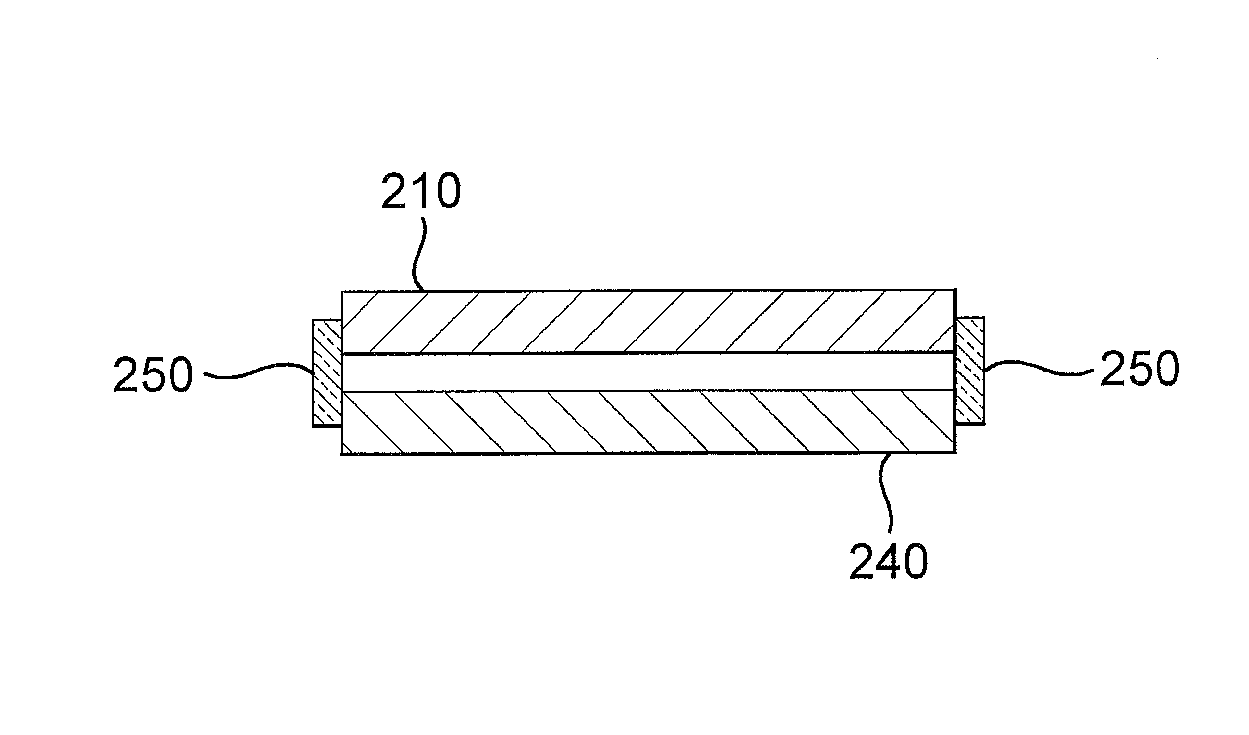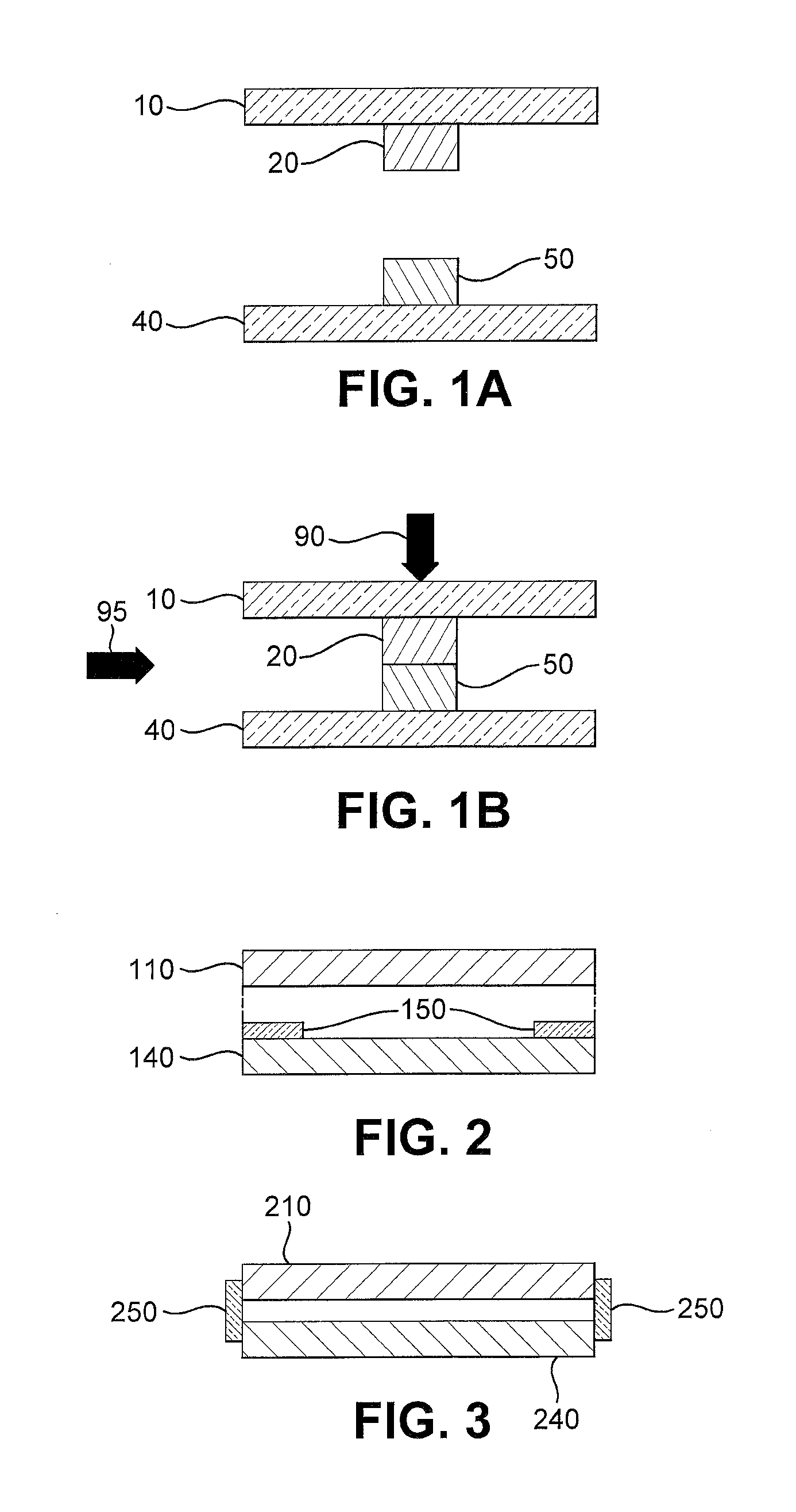Formation of glass-based seals using focused infrared radiation
a technology of infrared radiation and glass-based seals, which is applied in the field of glass-based seals using focused infrared radiation, can solve the problems of thermally stable components within the seal, large energy consumption, and short sealing time limits, and achieves the effects of reducing power/energy density, avoiding fractures, and minimizing voids and foaming
- Summary
- Abstract
- Description
- Claims
- Application Information
AI Technical Summary
Benefits of technology
Problems solved by technology
Method used
Image
Examples
example 1
[0087]A bead of low-temperature enamel paste A was applied to a 3″×3″×3 mm glass substrate, dried at 160° C., and then prefired at 350° C. This is conceptually depicted in FIG. 1A, where enamel 20 and / or 50 is applied to at least one of substrates 10 and / or 40. Enamels 20 and 50 are brought into physical contact with one another to form a pre-fired assembly, shown in FIG. 1B. At this point, the pre-fired assembly is irradiated with broadband infrared radiation as disclosed elsewhere herein. In alternate embodiments the irradiation can come through one of the substrates as shown by arrow 90, or from the side (directly incident on the seal material) as shown by arrow 95.
[0088]
TABLE 9Ingredients of Paste A.Paste Awt %Frit A78.31C31 vehicle19.88Byk 410 (thixotrope)0.28Solsperse 38500 (dispersant)1.81Total:100.28
[0089]
TABLE 10Glass Frit compositions of the invention - oxides in mole %OxideFrit AFrit BFrit CLi2O6.88Na2O8.68K2O2.01CaO0.67BaO0.67ZnO11.491.3228.57B2O312.0228.2918.48Al2O31.34...
example 2
[0093]A bead of enamel paste A was applied to a 3″×3″×3 mm glass substrate and dried at 160° C. A blank glass substrate was placed on top of this predried substrate. A thin glass plate was placed below, and two microscope sides were placed on top of this sandwich. The assembly was then placed in a heated press between the metal platens, with the platen temperature set at 320° C. A broadband infrared lamp (2000 W, 10″ lamp focused to a ¼″ line) was used to irradiate the enamel from the side at 100% power for 100 seconds. An assembly is formed with one side sealed. A strongly bonded seal was formed on the edge with no evidence of fractures from thermal shock or thermal expansion mismatch. This example shows that while a prefired enamel may help produce a quality seal by avoiding binder burnout issues, a dried enamel paste can also be used. Likewise, even an as-deposited paste or extrusion can be used directly so long as some spacing material or method is used to prevent excessive spre...
example 3
[0094]An 800 micron high bead of enamel paste B was applied to a 3″×3″×3 mm glass substrate and dried at 160 C. A blank glass substrate was placed on top of this predried substrate. A 3″×3″×0.7 mm glass plate was placed above and below these substrates, the assembly was placed in a heated press between metal platens, and the press heated to 320° C. One edge of the assembly was irradiated using a 2000 W, 10″ broadband IR lamp focused to about a 3 mm height at a setting of 85% power for 5 minutes. The edge was successfully sealed.
PUM
| Property | Measurement | Unit |
|---|---|---|
| sealing temperature | aaaaa | aaaaa |
| focal length | aaaaa | aaaaa |
| focal length | aaaaa | aaaaa |
Abstract
Description
Claims
Application Information
 Login to View More
Login to View More - R&D
- Intellectual Property
- Life Sciences
- Materials
- Tech Scout
- Unparalleled Data Quality
- Higher Quality Content
- 60% Fewer Hallucinations
Browse by: Latest US Patents, China's latest patents, Technical Efficacy Thesaurus, Application Domain, Technology Topic, Popular Technical Reports.
© 2025 PatSnap. All rights reserved.Legal|Privacy policy|Modern Slavery Act Transparency Statement|Sitemap|About US| Contact US: help@patsnap.com


